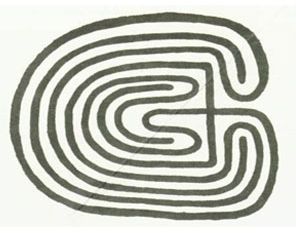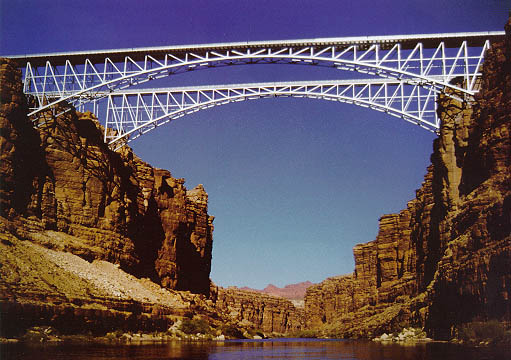Blue Highways: Pioche, Nevada
Unfolding the Map
Click on thumbnail for mapOur latest stop with William Least Heat-Moon (LHM) is in Pioche, Nevada. It is the home of a rich mining town history, complete with lives cut short by the gun. It is a boom and a bust and a boom town. It is a current ghost town. It all leads me to speculate on whether I would have made a good pioneer (I wouldn't have, I think). Click on the thumbnail of the map to the right to see where I most likely would have met my maker.
Book Quote
"Pioche...was pure Nevada. Its elevation of six thousand feet was ten times its population; but during the peak of the mining boom a century ago, the people and the feet above sea level came to the same number. The story of Pioche repeats itself over Nevada: Indian shows prospector a mountain full of metal; prospector strikes bonanza; town booms for a couple of decades with the four "G's": grubstakes, gamblers, girls, gunmen (seventy-five people died in Pioche before anyone died a natural death); town withers. By 1900, Pioche was on its way to becoming a ghost town like Midas, Wonder, Bullion, Cornucopia. But, even with the silver and gold gone, technological changes in the forties made deposits of lead and zinc valuable, and cheap power from Boulder Dam (as it was then) kept Pioche alive."
Blue Highways: Part 5, Chapter 5
 Downtown Pioche, Nevada. Photo by Don Barrett at Flickr. Click on photo to go to site.
Downtown Pioche, Nevada. Photo by Don Barrett at Flickr. Click on photo to go to site.
Pioche, Nevada
I am frustrated as I wrote a very nice post, but I somehow lost it. Sometimes, writing a blog is maddening. When something is saved, and then isn't, it can be very disheartening. However, I will soldier along and try to reconstruct something of what I had.
I have never been to Pioche, Nevada. In fact, I got my first experience of what is probably true Nevada, which is very different than Las Vegas, when I persuaded my wife that we should load up our car and drive with our dog to visit my family in California. Our route took us over US 50, which stretches from Ocean City, Maryland to Sacramento, California. Nevada touts its stretch of US 50 as "the loneliest road in America." They're probably right - the road rolls through very few towns along the length of Nevada. But what struck me was that the towns maintained the feel of old West towns. It was as if I were traveling through Old West towns where the only improvements made were pavement and streetlights.
Most of the towns through Nevada appeared to get their start due to the industries that extracted ores from the ground, mostly gold and silver. These were rough places, as LHM indicates in his passage above. Thanks to westerns I was like a lot of other people who romanticize the Old West. I used to think it would have been exciting had I lived on the edge of the frontier, helping to build a community and establishing a business or settling "virgin" land (we tend to conveniently forget about the original native inhabitants). But something always sat wrong with me. In my present life, I have high blood pressure, I suffer from allergies, I have poor eyesight. In my childhood I had two bouts with pneumonia, chronic bronchitis, and all the other childhood diseases. I once asked, rhetorically in the presence of a friend who was planning to go to medical school, how it was that people with such maladies made it on the frontier. She looked at me like I was a little crazy, and then said flatly, "they didn't."
It is easy to forget that towns like Pioche, and other settlements throughout the Old West, were difficult places to live. LHM relates an astounding fact, if it is true, that 72 people died by violence before the first person in Pioche died a natural death. Certainly such towns were lawless. They were settled by men who worked hard in the day and played hard at night - usually fueled by liquor. Women were few and far between. The first women to settle in such towns were usually prostitutes, followed by entertainers, followed by a few female entrepreneurs. Not all the business was legal, and crimes resulted in feuds, gunplay, and death.
When I now think about that Old West romance, I remember that given what I know right now, I might not have survived. The attack of gallstones that I had a few years ago that occasioned the removal of my gall bladder would have probably killed me back then. If there were even any attempts to surgically repair me, I would have been under the knife of a person quite possibly never trained in a medical school, and perhaps even just a barber. The kidney stone I suffered would have gone untreated, or the treatment would have been worse than just suffering through them. If I were a miner or other working class person, I wouldn't have been able to afford glasses for my eyes, which probably wouldn't have worked that well for me anyway given the science of the times. I wouldn't have had the antihistamines to relieve my allergies, or the steroid inhaler to relieve any asthma from those allergens. My high blood pressure would really have been a silent killer - but only if I managed to avoid getting shot, or cut badly on the job and then developing infection. I probably would have been lonely, without much in the way of female companionship unless I paid for it. Of course, that would have led to possible STD like syphilis or gonorrhea. I might have ended up crazy as a loon from untreated syphilis. Nope, the frontier can seem romantic, but it often wasn't.
I still enjoy, however, listening to the stories of those who were pioneers. My grandmother used to tell me her stories about growing up in Northern California, where her grandfather and father ran a sawmill. It was the edge of the frontier in the late 1800s and early 1900s. My mother grew up in the forests as well because her father was a logger and she lived in logging camps until she went to high school. When I heard those stories, I heard about a life of hard work, but also a life that was filled with wonder and possibility.
Sometimes I think I'm too jaded now, except in rare situations where I can let my mind be free of all the clutter it has collected through the years, to experience that kind of feeling. I don't quite understand what it is like to walk out of one's door and see nothing but wilderness and realize that it can be a playground, like my mother and grandmother saw when they were young. Nor do I understand what it is like to build something from the ground up. The basics have already been built for me - I just add my little embellishments to the structure already in place. To me, that's what a pioneer does. He or she builds something where there was nothing before. If it wouldn't kill me, I think I'd like being a pioneer, and building a Pioche, or some other place, out of nothing.
Musical Interlude
Today's musical interlude has nothing to do with Pioche, Nevada or any western state except perhaps in its name. U2's Silver and Gold is about apartheid in historical South Africa. However, here's my stretch to make it relevant. As seen above, pursuit of riches, represented by silver or gold, has led to lots of violence of suffering. It doesn't matter if it is by gunplay and terror in Pioche, or through enslavement for foreign occupiers in South Africa. Silver and gold may be pretty, but the behaviors it can incite in some are not.
If you want to know more about Pioche
Ghosttowns.com: Pioche
Lincoln County: Pioche
Lincoln County Record (newspaper)
Overland Hotel
Pioche History
TravelNevada.com: Pioche
Wikipedia: Pioche
Next up: Somewhere on US 93, Nevada




 Tuesday, April 26, 2011 at 9:56PM
Tuesday, April 26, 2011 at 9:56PM


